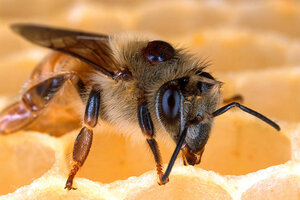One in four honeybee colonies died off this winter, and that's an improvement
A USDA survey of beekeepers found that 23 percent of bee colonies collapsed this winter, less than the eight-year average of 30 percent.

This undated handout photo provided by the US Department of Agriculture shows the deadly parasitic Varroa mite on the back of this honey bee.
Scott Bauer/Agriculture Department/AP
Washington
Nearly one out of four American honeybee colonies died this winter — a loss that's not quite as bad as recent years, says a new U.S. Department of Agriculture survey of beekeepers.
Under siege from parasites, disease, pesticide use, nutrition problems and a mysterious sudden die-off, 23 percent of bee colonies failed and experts say that's considerably less than the previous year or the eight-year average of 30 percent losses.
"It's better news than it could have been," said Dennis van Engelsdorp, a University of Maryland entomology professor who led the survey. "It's not good news."
Before a parasitic mite — just one of a handful of problems attacking the crucial-for-pollination honeybees — started killing bees in 1987, beekeepers would be embarrassed if they lost more than 5 or 10 percent of their colonies over the winter. Now they see a 23 percent loss as a bit of a break, said survey co-author Jeff Pettis, USDA's bee research chief.
"It's encouraging that if anything it's not a steady downward trend," said University of Illinois entomology professor May Berenbaum, who wasn't part of the survey of 7,200 beekeepers.
David Mendes, a North Fort Myers beekeeper and past president of the American Beekeeping Federation, thinks the numbers are lower than reality. His losses were around 30 percent, he said. And then earlier this year there was a massive die-off in the California almond fields, where "probably 100,000 hives got nailed," he added.
The experts aren't certain why this year wasn't as bad as previous years. Maybe 2012-2013 was so bad that beekeepers had to try harder to keep bees alive and baby their hives more, Pettis said.
There's no one reason for the losses, Pettis and others said. Several years ago they were surprised by a sudden die-off, called colony collapse disorder, but that has gone away the past few years, they said.
Pettis and van Engelsdorp said now the problem seems to be a combination of parasitic varroa mites, a relatively new class of pesticides, and poor nutrition because there's a lack of diversity in crops where they get their pollen.
Honeybees pollinate more than 90 of the world's flowering crops, including apples, nuts, broccoli, squash, citrus fruit, berries and melons.
It's getting to the point where many beekeepers can't keep afloat, van Engelsdorp, Pettis and beekeeper Mendes said.
"It's a really wild ride," Mendes said. "It's not a whole lot of fun."
Copyright 2014 The Associated Press. All rights reserved. This material may not be published, broadcast, rewritten or redistributed.

